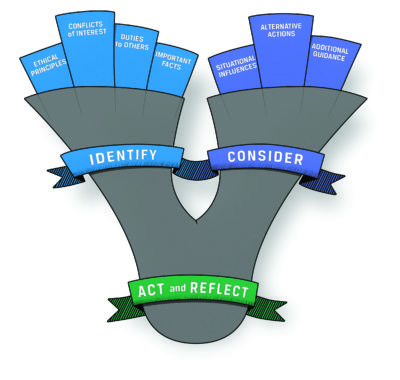Ethics in Practice: When Is Scrutinizing Risk Not Enough? Case for Week of 19 February
Are you ready to see how your choice compares to the analysis. Check it out below.
Assessing risk is a key part of choosing what securities to include in a client’s portfolio. But is there more that needs to be taken into consideration before making a decision?
Case
Aaron Bouchard is a portfolio manager with discretionary control over the portfolios of more than 400 clients. Bouchard pursues a “medium risk, value” strategy for his clients, and they hire him on that basis. After scrutinizing the risk of potential investments, he makes a risk assessment for each of the securities he recommends based on the risks facing the issuer’s business. The majority of securities Bouchard invests his clients’ assets in are small-cap companies in the oil and gas sector and in commodities that he considers “medium” risk. As a result, Bouchard’s client accounts are concentrated in those sectors. Bouchard’s actions are
- acceptable if he discloses his investment strategy to his clients.
- unacceptable because he does not exercise diligence and thoroughness in executing his investment strategy.
- acceptable if he maintains appropriate records to support his investment recommendations and actions.
- unacceptable because he does not have a reasonable and adequate basis to support his investment recommendations and actions.
Analysis
This case involves CFA Institute Standard V(A): Diligence and Reasonable Basis, which states that members and candidates “must exercise diligence, independence, and thoroughness in analyzing investments, making investment recommendations, and taking investment actions.” Under this standard, members must also “have a reasonable and adequate basis, supported by appropriate research and investigation” for making investment recommendations and taking investment action. In this case, there is nothing to indicate that Bouchard’s investigation and analysis of the individual securities that he chooses for his clients’ accounts is insufficient or inadequate. The facts state that he “scrutinizes” the risk of potential investment on an individual basis. But in making the investment decisions, he does not appear to exercise diligence or thoroughness because he does not give sufficient weight to factors that go beyond long-term risk of the individual securities themselves. Bouchard does not consider such factors as security concentration in client portfolios, price volatility in the short term, or liquidity risk. Without considering all these factors in their entirety, Bouchard’s actions underweight the risk of the securities, likely making them a more risky investment for his clients than the “medium” risk that he has assigned. Because he does not exercise diligence and thoroughness when implementing his investment strategy, disclosing his strategy to his clients or maintaining adequate records for a faulty strategy will not cure the misconduct. In this case, the best choice is B.
Have an idea for a case for us to feature? Send it to us at [email protected].
More About the Ethics in Practice Series
Just as you need to practice to become proficient at playing a musical instrument, public speaking, or playing a sport, practicing assessing and analyzing situations and making ethical decisions develops your ethical decision-making skills. To promote “ethical exercise,” we are excited to introduce Ethics in Practice.
Each week, we post a short vignette, drawn from real-world circumstances, regulatory cases, and CFA Institute Professional Conduct investigations, along with possible responses/actions. We then encourage you to assess the case through the lens of the Ethical Decision-Making Framework and the CFA Institute Code of Ethics and Standards of Professional Conduct and let us know which of the choices you believe is the right thing to do and why. If you are not a CFA Institute member, you can post your choice and reasoning in the comments section below. For CFA Institute members, we would like you to join the conversation in our Member App and post your responses there. Later in the week, we will post an analysis of the case and you can see how your response compares.
If you liked this post, consider subscribing to Market Integrity Insights.
Image Credit: ©CFA Institute

